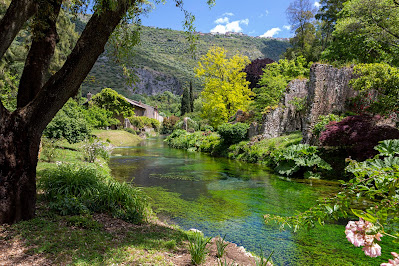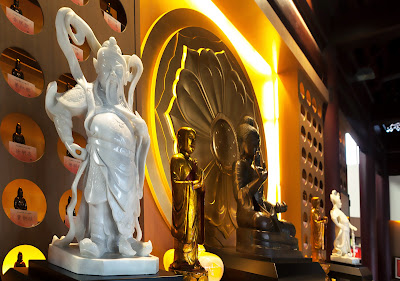Wow, it seems like we've been a long time cooped up in our homes with so many restrictions vis a vis getting out and about. No just jumping in the car and escaping the city.
But now that museums and such like are once again open, I booked for the two of us to go to the Giardino di Ninfa, not far from Cisterna di Latina. I have driven to Cisterna many a time in the past, but not for a while. So knowing I was bound to get lost thought I would leave it to Google Maps to get us there, but it got us lost too. But we eventually found the right route and arrived around 11am.
At the moment with Covid one essential is booking on line. You cannot just turn up nowadays. So try to get a slot for the morning. We passed by again after lunch and the car park was packed, and if you want to get photos trying to keep other visitors out of your view finder will be impossible when it gets busy.
You are not allowed to roam willy nilly, an easily followed route meanders around the garden and every twenty metres or so a well informed guide will explain and describe the plants around you.
THE GARDEN OF NINFA
The Garden of Ninfa is a landscaped garden in the English style set among the ruins of the medieval town of Ninfa, near Cisterna in Latina, 60 miles south of Rome.
In 1297 the Caetani family acquired the town which in 1381 was sacked and destroyed following the schism between the Antipope Clement VII of Avignon (whom the Caetani's supported) and Pope Urban VI in Rome. Even so, over the following centuries local inhabitants continued to use the churches of the town, the ruins of six of which are still visible. The garden itself was created in 1921 by Ada Bootle Wilbraham, English wife of Onorato Caetani, with the help of two of her sons, Gelasio and Roffredo Caetani.
The garden covers eight hectares and is irrigated by the river Ninfa plus several irrigation streams and is planted with trees, shrubs and plants from all over the world. Near the church of San Giovanni there is an American walnut tree, ornamental apple trees, a red beech, and a Japanese pink-leaved maple tree. Behind the church of Santa Maria Maggiore there is a yellow bignonia and several rose bushes. The cypress avenue is planted with erythrina crista-galli, also known as the cockspur coral tree. In the vicinity of the Roman bridge there are jasmines, wisterias and a plantation of Chinese bamboo. Elsewhere in the garden there are banana trees, papyruses, a cedar and an Australian casuarina tenuissima, a eucalyptus, a star magnolia, climbing hydrangeas, and a liriodendron tulipifera, otherwise known as a tulip tree due to its tulip like flowers.
The flower of the tulip tree.It is classified as a Regional Natural Monument and has been described by the New York Times as the most beautiful in the world. The Director of the British Royal National Rose Society said of it, "The site is one of sublime romantic beauty, where time seems to stand still".
Bottlebrush flowers(Callistemon)
For booking, and how to get there, go to the website:








































